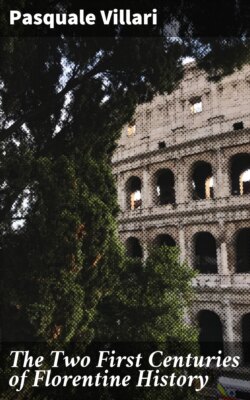Читать книгу The Two First Centuries of Florentine History - Pasquale Villari - Страница 19
На сайте Литреса книга снята с продажи.
VII.
ОглавлениеTable of Contents
Meanwhile, which party conquered in the struggle following Matilda's death? Facts prove it clearly enough. In the year 1119 the Florentines made that final assault on the castle of Monte Cascioli, to which reference has been already made. This is the moment when the before-mentioned Rempoctus,118 or Rabodo, really comes upon the scene, although Villani (iv. 29) and other chroniclers make him appear in 1113, under the name of Robert the German, Imperial vicar, and suppose him to have fallen in fight that year while defending the castle. We have shown that there could be no Imperial vicar in Tuscany at that date, seeing that none was sent until after Matilda's decease. In fact, no documents mention any vicar before then, and only on September 11, 1116, we find one recorded as "Rabodo ex largitione Imperatoris Marchio Tuscia,"119 and then in 1119, "Rabodo Dei gratia si quid est,"120 the identical formula that had been employed in Matilda's patents. In 1120 Rabodo's name disappears, and is replaced by that of the Margrave Corrado. It may therefore be taken for granted that Rabodo really perished in 1119 during the defence of Monte Cascioli against the Florentines, who now succeeded in finally demolishing the stronghold and burning it to the ground.121 Thus their first achievement, after Matilda's decease, was the destruction of a Cadolingi castle, together with the defeat and death in battle of the first Imperial vicar then established in Tuscany. This is more than enough to show the nature of their attitude with regard to the Empire and the Teutonic party.
Shortly after, an event of even greater significance occurred in the capture and sack of Fiesole during 1125. Sanzanome, whose so-called modern history of Florence starts with this war, describes it at much length, in flights of wordy rhetoric. The gist of it is that the chief cause of the conflict was a commercial dispute. The people of Fiesole would seem to have maltreated and plundered a Florentine trader who was quietly passing through the city with his goods. This incident, added to the remembrance of past rancours and other recent depredations, seems to have stirred the Florentines to war. Instantly, "factum est Consilium per tunc dominantes Consules de processu." One of the leading citizens harangued the people, beginning his speech with these words: "Si de nobili Romanorum prosapia originem duximus … decet nos patrum adherere vestigiis." Thereupon, "illico a Consulibus exivit edictum." A man of Fiesole, on the other hand, began his address by alluding to the legendary origin of his city: "Viri, frates, qui ab Ytalo sumpsistis originem, a quo tota Ytalia dicitur esse derivata." Although so much learned rhetoric in a writer of the early part of the thirteenth century is another proof of the strong influence of Roman tradition on ancient Florentines, both before and after the rise of their Commune, it cannot conceal the real cause of the war, as proved even by the evidence of Villani, whose chronicle begins to acquire greater historic value at this point. The latter relates that Fiesole had become a veritable nest of Cattani and brigands, who infested the Florentine highways and territories.122 As usual, the feudal barons were swooping down from their strongholds to hinder the trade and traffic of the Commune.
At this moment also there were special causes tending to provoke a war of an unusually sanguinary kind. The counties, or contadi, of the two cities, as sometimes occurred elsewhere, had been carved out of the territories of bishoprics, based, in their turn, on ancient Roman partitions of the soil. Accordingly, these counties being not only adjacent, but wedged in and almost tangled one with the other, and their respective bishops having never wielded, as in Lombardy, the authority or power of counts they had ended by forming a single, combined jurisdiction. In fact, many documents refer to the county or jurisdiction of Fiesole and Florence, as though it were one and the same thing. Hence it was only natural that on becoming an independent Commune, after Matilda's death, Florence should seek to dominate over both counties, and equally natural that Fiesole should be violently opposed to the idea, and, notwithstanding the inferior size of the town, should have trusted to the superior strength of its fortified position, and, making alliance with the nobles of the contado, should have harboured them in the citadel, and joined them in continual attacks on Florentine traders or in raiding Florentine lands. This was the beginning of the war. Its details are unknown to us, those supplied by Sanzanome being too extravagant for belief,123 and other chroniclers furnishing none at all. Seeing the strength of Fiesole's position, the campaign could have been neither short nor easy, and undoubtedly ended in cruel slaughter and the almost total destruction of the town. The chroniclers are not the only authorities for this fact. Shortly afterwards, the Abbot Atto of Vallombrosa implored a pardon from Pope Honorius II., pro Florentinorum excessibus, urging in their favour that there were many aged persons, women, and children, in Florence, who had assuredly taken no part in the destruccio fesulana, and also that many participants in the war now confessed the error of their ways, and sincerely repented all the excesses that "non meditata nequitia commisere."124 The event was long remembered in Florence, is frequently recorded in documents,125 and, together with the rout of the Imperial vicar at Monte Cascioli, undoubtedly contributed to establish the independence of the Commune on a firmer basis.
